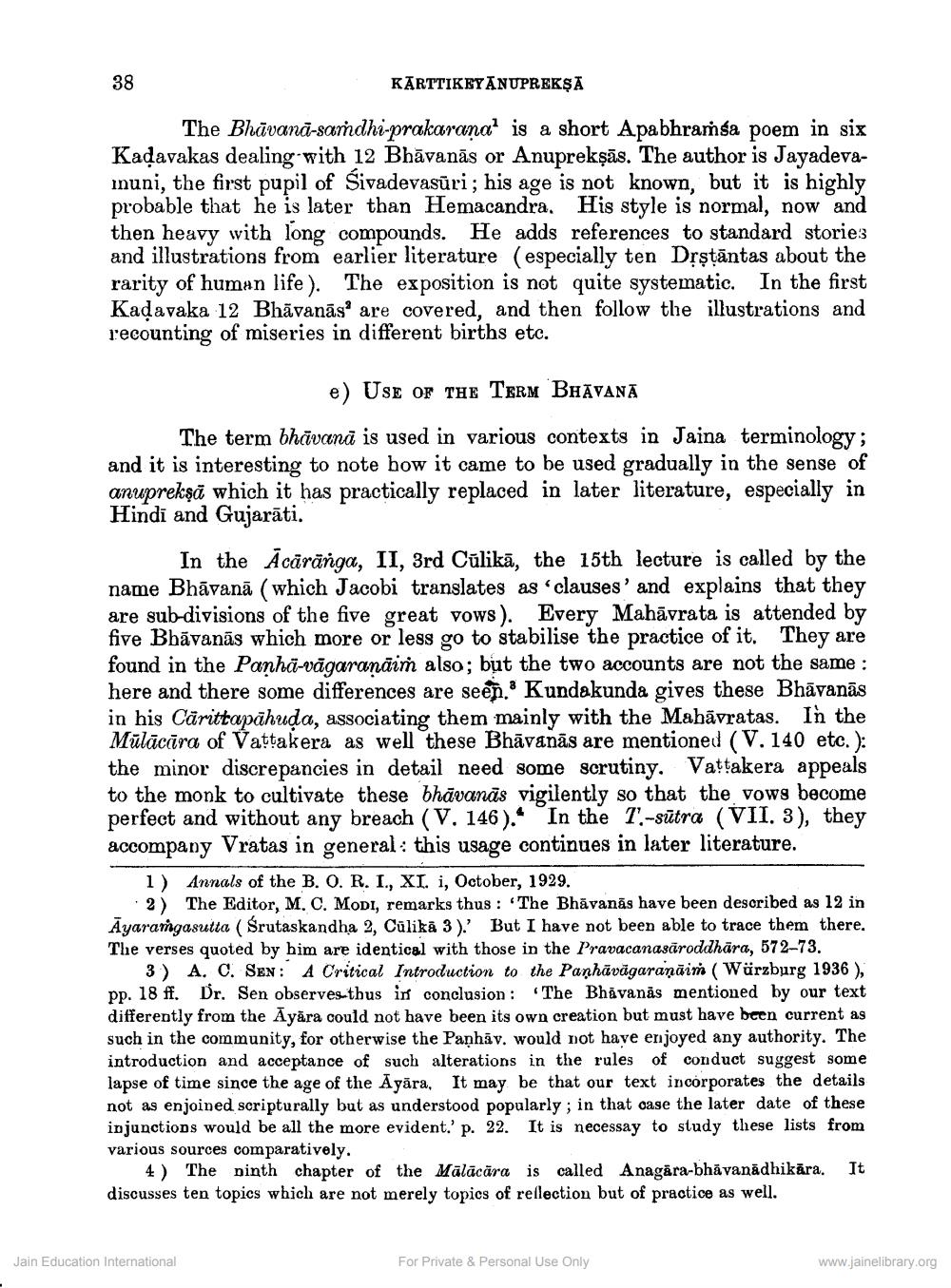________________
38
KĀRTTIKEYANUPREKŞĀ
The Bhāvanā-sardhi-prakarana' is a short Apabhraṁsa poem in six Kadavakas dealing with 12 Bhāvanās or Anuprekşās. The author is Jayadevainuni, the first pupil of Sivadevasūri; his age is not known, but it is highly probable that he is later than Hemacandra. His style is normal, now and then heavy with long compounds. He adds references to standard stories and illustrations from earlier literature (especially ten Drşțāntas about the rarity of human life). The exposition is not quite systematic. In the first Kadavaka 12 Bhāvanās are covered, and then follow the illustrations and recounting of miseries in different births etc.
e) USE OF THE TERM BHĀVANĀ
The term bhāvanā is used in various contexts in Jaina terminology; and it is interesting to note how it came to be used gradually in the sense of anuprekşā which it has practically replaced in later literature, especially in Hindi and Gujarāti.
In the Ācāränga, II, 3rd Cūlikā, the 15th lecture is called by the name Bhāvanā (which Jacobi translates as 'clauses' and explains that they are sub-divisions of the five great vows). Every Mahāvrata is attended by five Bhāvanās which more or less go to stabilise the practice of it. They are found in the Panha-vägaranāim also; but the two accounts are not the same : here and there some differences are seen. Kundakunda gives these Bhāvanās in his Carittapähuda, associating them mainly with the Mahāvratas. In the Mūlācāra of Vattakera as well these Bhāvanās are mentioned (V. 140 etc.): the minor discrepancies in detail need some scrutiny. Vattakera appeals to the monk to cultivate these bhāvanās vigilently so that the vows become perfect and without any breach (V. 146). In the 1.-sūtra (VII. 3), they accompany Vratas in general: this usage continues in later literature.
1) Annals of the B. O. R. I., XI. i, October, 1929.
2) The Editor, M. C. MODI, remarks thus : The Bhāvanās have been described as 12 in Ayaramgasutta ( Śrutaskandha 2, Cālikā 3). But I have not been able to trace them there. The verses quoted by him are identical with those in the Pravacanasāroddhāra, 572-73.
3) A. C. Sen: A Critical Introduction to the Panhāvāgaranāin (Würzburg 1936 ), pp. 18 ff. Dr. Sen observes thus ir conclusion: The Bhāvanās mentioned by our text differently from the Ayāra could not have been its own creation but must have been current as such in the community, for otherwise the Panhāv. would not have enjoyed any authority. The introduction and acceptance of such alterations in the rules of conduct suggest some lapse of time since the age of the Ayära. It may be that our text incorporates the details not as enjoined, scripturally but as understood popularly ; in that case the later date of these injunctions would be all the more evident,' p. 22. It is necessay to study these lists from various sources comparatively.
4) The ninth chapter of the Mālācāra is called Anagara-bhāvanādhikāra. It discusses ten topics which are not merely topics of reflection but of practice as well.
Jain Education International
For Private & Personal Use Only
www.jainelibrary.org




